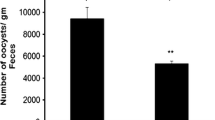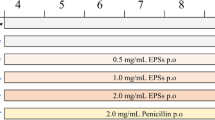Abstract
To evaluate the role of reactive oxygen species (ROS) in Shigella dysenteriae 1 toxin (STx) mediated intestinal infection, the ligated rabbit small intestinal loops were injected with STx. The enterocytes isolated from STx treated rabbit ileal loops had a significantly higher level of lipid peroxidation as compared to enterocytes isolated from control rabbit ileum. To study the role of second messengers in STx mediated intestinal damage, the in vivo and in vitro effects of modulators of lipid peroxidation of enterocytes were used. The presence of Ca2+-ionophore A23187 enhanced the extent of lipid peroxidation in enterocytes isolated from the control and STx treated rabbit ileum. However, l-verapamil only marginally decreased the lipid peroxidation level of enterocytes isolated from STx treated rabbit ileum. The in vitro effect of modulators was in agreement with in vivo studies. Dantrolene significantly decreased the extent of lipid peroxidation of enterocytes isolated from STx treated rabbit ileum. PMA significantly increased the lipid peroxidation level of enterocytes isolated from control ileum. However, PMA could not further enhance the lipid peroxidation level of enterocytes isolated from STx treated rabbit ileum. The presence of H-7 significantly decreased the extent of lipid peroxidation of enterocytes isolated from STx treated rabbit ileum. In vitro effect of PMA and H-7 was in agreement with that of in vivo findings. The role of arachidonic acid metabolites, prostaglandins (PGs), in mediating STx induced lipid peroxidation was also studied. The presence of indomethacin (a PG synthesis inhibitor) significantly decreased the lipid peroxidation induced by STx. These findings suggest that lipid peroxidation induced by STx is mediated through cytosolic calcium. The increase in (Ca2+)i leads to activation of PKC.
A significant decrease in the enterocyte levels of antioxidant enzymes superoxide dismutase, catalase and reduced glutathione in STx treated rabbit ileum as compared to control was seen. A significant decrease in vitamin E levels was also observed. This suggests that there is decreased endogenous intestinal protection against ROS in STx mediated intestinal infection which could contribute to enterocyte membrane damage that ultimately leads to changes in membrane permeability and thus to fluid secretion.
Similar content being viewed by others
References
Keusch GT, Grady GF, Mata LJ, Mclver J: The pathogenesis of Shigells diarrhoea I. Enterotoxin production by Shigella dysenteriae 1. J Clin Invest 51: 1212–1218, 1972
Oshitani N, Kitano A, Okabe H, Nakamura S, Matsumoto T, Kobayashi K: Location of superoxide anion generation in human colonic mucosa obtained by biopsy. Gut 34: 936–938, 1993
Kehrer JP, Smith CV: Free radicals in biology: Sources, reactivities and roles in the etiology of human diseases. In: B Frei (ed). Natural Antioxidants in Human Health and Disease. Orlando FL. Academic Press, pp 25–62
Pryor WA: Free radicals and lipid peroxidation: What they are and how they got that way. In: B Frei (ed). Natural-Antioxidants in Human Health and Disease. Orlando, FL. Academic Press, pp 1–24
Powell DW: Immunophysiology of intestinal electrolyte transport. In: RA Frizzel (ed). Handbook of Physiology: the gastrointestinal system. Rockville MD. Am Physiol Soc, 1991, pp 591–641
Powell DW: New paradigms for the pathophysiology of infectious diarrhoea. Gastroenterology 106: 1705–1707, 1994
Kaur T, Singh S, Ganguly NK: Role of enteric nervous system in Shigella dysenteriae type 1 toxin mediated fluid secretion in rabbit ileum. J Diarr Dis Res 13: 139–145, 1995
Edward PR, Ewing WH: The genus Shigella. In: Edwards and Ewing (eds). Identification of Enterobacteriaceae. Elsevier, New York, 1986, pp 135–172
Griffin DE, Gamski P: Release of shiga toxin from Shigella dysenteriae 1 by polymyxin B. Infect Immun 40: 425–429, 1983
De SN, Chatterjee DN: An experimental study on the mechanism of action of Vibrio cholerae on the intestinal mucous membrane. J Pathol Bacteriol 66: 559–562, 1953
Pinkus LM: Separation and use of enterocytes. Meth Enzymol 778: 154–162, 1981
Toyodo S, Lee PC, Labenthal E: Physiological factors controlling release of enterokinase from rat enterocytes. Dig Dis Sci 30: 1174–1180, 1985
Khurana S, Ganguly NK, Khullar M, Panigrahi D, Walia BNS: Studies on mechanisms of Salmonella typhimurium enterotoxin – mediated diarrhoea. Biochem Biophys Acta 1097: 171–176, 1991
Utley HG, Bernheim F, Hochstein P: Effect of sulphydryl reagents on peroxidation in microsomes. Arch Biochem Biophys 118: 29–32, 1967
Moron MS, Depierre JW, Mauenervik B: Levels of glutathione, glutathione reductase and glutathione-S-transferase activities in rat liver and lung. Biochem Biophys Acta 582: 67–78, 1979
Beers RF, Sizer IW: A spectrophotometric method for measuring breakdown of hydrogen peroxide by catalase. J Biol Chem 195: 133–140, 1952
Paglia DE, Valentine WN: Studies on the quantitative and qualitative characterization of red blood cells glutathione peroxidase. J Lab Clin Med 70: 158–169, 1967
Kono Y: Generation of superoxide radical during auto oxidation of hydroxylamine and an assay for superoxide dismutase. Arch Biochm Biophys 186: 189–195, 1978
Turnham DI, Smith E, Flora PS: Concurrent lipid chromatographic assay of retinol, α-tocopherol, β-carotene, lycopene and β-cryptoxanthine in plasma with tocopherol acetate as internal standard. Clin Chem 34: 377–381, 1988
Lowry OH, Rosebrough NJ, Farr AL, Randall RJ: Protein measurement with folin phenol reagent. J Biol Chem 193: 265–275, 1951
Simmonds NJ, Alien RE, Stevens TRJ, Van Someren RNM, Blake DR, Rampton DS: Chemiluminescence assay of mucosal reactive metabolites in inflammatory bowel disease. Gastroenterol 103: 186–196, 1992
Kolharat M, Munich Z: Studies of the inhibitory effect of verapamil on the slow inward current in mammalian myocardium. J Mol Cell Cardiol 10: 1037–1042, 1978
Kaur T, Singh Surjit, Verma M, Ganguly NK: Calcium and protein kinase C play an important role in Shigella toxin induced fluid secretion in vivo and in vitro. Biochim Biophys Acta (in press)
Blaustein MP, Rasgadoflores H: The control of cytoplasmic free calcium in presynaptic nerve terminals. In: Calcium and Phosphate Transport Across Biomembranes. F Bronner, M Peterlik (eds). Academic Press, New York, pp 53–58
O'Brian CA, Ward NE, Weinstein JB, Bull AW, Marnett LJ: Activation of rat brain protein kinase C by lipid oxidation products. Biochem Biophys Res Commun 155: 1374–1384, 1988
Nishizuka Y: Studies and perspectives of protein kinase C. Science 233: 305–312, 1986
Johnson A, Phillips P, Hocking D, Tsan MF, Ferro T: Am J Physiol 256: H1012–H1022
Hidaka H, Inagaki M, Kawamoto S, Sasaki Y: Isoquinolsulfonamides, novel and potent inhibitors of cyclic nucleotide dependent protein kinase and protein kinase C. Biochemistry 23: 5036–5041, 1984
Launstein K, Laursen LS, Bukhave K, Rask Madsen J: In vivo effects of orally administered prednisolone on prostaglandin and leukotriene production in ulcerative colitis. Gut 28: 1095–1099
Gustafson C, Undahl M, Tagesson C: Hydrogen peroxide stimulates phospholipase A2-mediated arachidonic acid release in cultured intestinal epithelial cells (INT 407). Scand J Gastroenterol 26: 237–247, 1991
Grisham MB, Hernandez LA, Smith BF: Interaction between oxygen radicals and gastric mucus. Am J Physiol 251: G567–G574, 1987
Keshavarzian A, Morgan G, Sedghi S: Role of reactive oxygen metabolites in experimental colitis. Gut 31: 789–790, 1990
Chen LEW, Kellogg III, Packer L: Photoinactivation of catalase. Photochem Photobiol 34: 125–129, 1981
Romano M, Razandi M, Ivey KJ: Role of sulphydryl compounds in the defense of rat gastric epithelial cells against oxygen reactive metabolite induced damage. Ital J Gastroenterol 23: 55–59, 1991
Jankowski J, Bridges AB, Scott N: Circulating free radical markers and peptic ulcer disease. Eur J Gastroenterol Hepatol 3: 823–828, 1991
Author information
Authors and Affiliations
Rights and permissions
About this article
Cite this article
Kaur, T., Singh, S., Dhawan, V. et al. Shigella dysenteriae type 1 toxin induced lipid peroxidation in enterocytes isolated from rabbit ileum. Mol Cell Biochem 178, 169–179 (1998). https://doi.org/10.1023/A:1006826829687
Issue Date:
DOI: https://doi.org/10.1023/A:1006826829687




